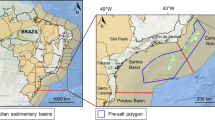Abstract
A typical ancient karst cave is found in the Yijianfang Formation of Ordovician at Liuhuanggou, North Tarim Basin. With an entrance of 4.8 m wide and 20 m high, the Liuhuanggou ancient karst cave extends to NW 315° and has been filled by sediments, which can be classified into three types according to their nature and origin: clastic sediments (gravels), chemical sediments (palaeotravertine), and mixed sediments. Among them, the Paleotravertine and gravels are most common. The palaeotravertine is laminated type and yellowish brown or black in color due to oil inside. When saturated with oil, the palaeotravertine is black. Under microscope, oil mainly accumulates in the cracks between calcite crystals. The filling period of the Liuhuanggou karst cave can be divided into three stages: mixed filling, chemical filling, and clastic (palaeotravertine breccia) filling. Numerous fractures are distributed on one side of the karst cave. The fractures can be as wide as 40 cm and over 40 m long. Fractures of different periods and sizes constitute a fracture network and are all filled with calcite veins. Oil can be found inside the fractures. In the chemical fillings, sulfur is also found, which can indicate the magma influence on karst caves. The existence of sulfur also confirms that the Liuhunggou karst cave was formed in ancient times rather than recently or nowadays. Different from normal sedimentary limestone, the ancient Liuhuanggou karst cave has a distinct isotope fractionation and the depletion of heavy carbon and oxygen isotope. Controlled by the northwest oriented vertical strike-slip shear fault, the karst cave is actually a dissolved vertical fault belt.
Similar content being viewed by others
References
Keith M H, Weber J N. Isotopic composition and environmental classification of selected limestones and fossils. Geochem Cosmochim Acta, 1964, 28: 259–260
Peng S P, He H, Shao L Y, et al. Carbon Iiotopic compositions of the Cambrian-Ordovician carbonates in Tarim Basin (in Chinese). J China Univ Mining Tech, 2002, 31: 353–357
Shao L Y. Relationship between carbonatite carbon and oxygen isotope and palaeotemperature (in Chinese). J China Univ Mining Tech, 1994, 23: 39–45
Craig H. Standard for reporting concentrations of deuterium and oxygen-18 in natural water. Science, 1961, 133: 1702–1703
Epstein S, Buchsbaum R, Lowenstam H, et al. Revised carbonatewater isotopic temperature scale. Bull Geol Soc Am, 1953, 64: 1315–1326
O’Neil J R. Oxygen isotope geothermometry. J Chem Phys Acta, 1969, 30: 5547–5558
Deines P. Stable isotope variations in carbonatites. In: Bell K, ed. Carbonatites: Genesis and Evolution. London: Unwin Hyman, 1989. 301–359
Wang Z R, Zhi X C, Zhou D C, et al. A preliminary study of the relationship between palaeotemperature of isotope and sea-level changes (in Chinese). J Stratig, 1997, 21: 289–292
Hong A S, Peng Z C, Li P. Isotopic geochemistry methods for paleotemperature studies of cave speleothems (in Chinese). Adv Earth Sci, 1995, 10: 348–352
Yu R L, Fu H, Tectogenesis’ influence on Ordovician carbonate reservoirs in Tahe Oilfield (in Chinese). Nat Gas Expl Dev, 2006, 29: 1–5
Huang B C, Zhu R X, Otofuji Y, et al. Discussion on the Caledon paleogeographic location of Main Land-mass in China. Chin Sci Bull, 2000, 45: 337–345
Zhao B, Zhao J S, Wang J C, et al. A new type of carbonatite: Carbonatite of crust origin (in Chinese). Geochemica, 2004, 33: 649–660
Nogueira A C R, Riccomini C, Sial A N, et al. Carbon and strontium isotope fluctuations and palaeoceanographic changes in the late Neoproterozic Araras carbonate platform, southern Amazon craton, Brazil. Chem Geol, 2007, 237: 168–190
Eickhoff K H, Von Der Borch C C, Grady A E, et al. Proterozoic canyons of the Flinders Ranges (South Australia): Submarine canyons or drowned river valleys? Sediment Geol, 1988, 58: 217–235
Calver C R. Isotope stratigraphy of the Ediacarian (Neoproterozoic III) of the Adelaide Rift Complex, Australia, and the overprint of water column stratification. Precambrian Res, 2000, 100: 121–150
Giddings J A, Wallace M W, Haines P W, et al. Submarine origin for the Neoproterozoic Wonoka canyons, south Australia. Sediment Geol, 2010, 223: 35–50
Author information
Authors and Affiliations
Corresponding author
Rights and permissions
About this article
Cite this article
Zhong, J., Mao, C., Li, Y. et al. Discovery of the ancient Ordovician oil-bearing karst cave in Liuhuanggou, North Tarim Basin, and its significance. Sci. China Earth Sci. 55, 1406–1426 (2012). https://doi.org/10.1007/s11430-012-4467-3
Received:
Accepted:
Published:
Issue Date:
DOI: https://doi.org/10.1007/s11430-012-4467-3




